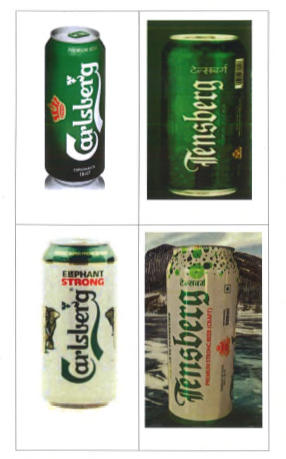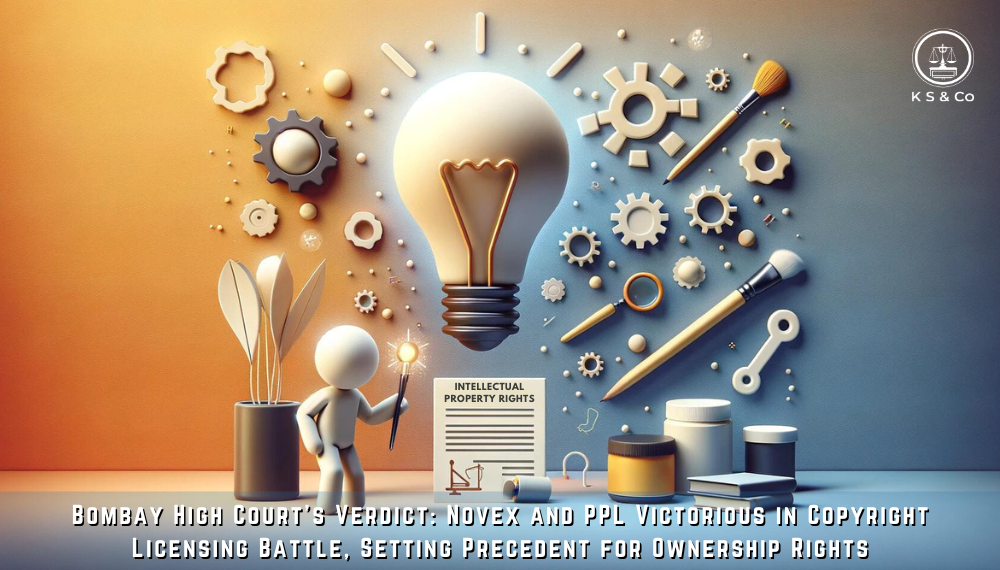Delhi High Court, 2nd August 2022
FACTS OF THE CASE –
The Diageo Brands B.V. (Plaintiff No. 1) is a manufacturer, seller and distributer of alcoholic beverages and proprietor of marks ‘Vat 69’ and ‘Black & White’. United Spirits Ltd. (Plaintiff No. 2) is Indian distributor of Plaintiff No. 1’s brands, i.e. ‘Vat 69’ and ‘Black &White’, and also manufactures, sells, and distributes it’s own brand, ‘Black Dog’. Plaintiff No. 1 is the proprietor of registered bottle design known as “Hipster” in India, which is used for selling ‘Black Dog (Black Reserve)’, ‘Black Dog (Golden Reserve)’, ‘Vat 69’ and ‘Black & White’. Plaintiffs also claim common law rights in trade dress of “Hipster” bottles. Plaintiff No. 1 launched the “Hipster” bottles in India in May, 2019.
The Defendant, Great Galleon Ventures Limited, is the manufacturer of alcoholic beverages sold under the brand ‘GOA’ and its variants, ‘GOA GOLD’ and ‘GOA SPIRT OF SMOOTHNESS’.
The Plaintiffs have alleged that the Defendant has been infringing their design rights and passing-off its the “Hipster” bottle design by selling its alcoholic beverages in 180 ml bottles having a similar design from February 2021. The Plaintiffs have sought for a permanent injunction and ancillary reliefs against the Defendant. The design of Plaintiff’s bottles (left) and Defendant’s bottles (right) is shown above:
On 23rd February 2021, the Delhi High Court had passed an ex parte ad-interim injunction in favour of the Plaintiff restraining the Defendant from selling the impugned bottles. The Defendant opposed this ex parte ad-interim injunction and sought for vacation of this order.
ARGUMENTS BY THE PARTIES –
The Plaintiffs argued that their design is unique and distinctive as its essential features is modelled on the shape of a smart phone, and never been adopted by a third-party. It’s essential features include: (a) tall and sleek look, (b) rectangular shape, (c) smooth rounded shoulders and symmetrical edges, (d) protruding V-shaped neck situated at the middle of both shoulders and (e) two-toned rimmed and rounded cap. They have spent considerable amount of expenses on marketing and promoting “Hipster” bottles and building goodwill and reputation in India. The “Hipster” Bottles have been a massive success as the Plaintiffs have sold bottles worth Rs. 100 crores in 1.5 years. It was alleged that the Plaintiff’s turnovers shows Defendant’s dishonest intention of adopted the impugned design for encashing upon the Plaintiff’s reputation. The Defendant was also deliberately selling the impugned bottles at a lesser price. The Plaintiffs also argued that they have common law rights in their trade dress, which acts as a source identifier.
The Defendant argued that the “Hipster” bottle is not novel and unique since it was a trade variant inspired by the “hip flask” design, which is extremely common in the liquor trade. The Plaintiff’s registered design lies in the public domain. The registered design is also functional with purpose of fitting in a pocket. The Defendant further alleged mosaicing in the Plaintiff’s design stating that they had created a design that was a combination of various other designs that were already commonly being used in the industry. Thus, there was no passing-off as designs of both goods were common-to-trade. The Defendant denied any infringement as their product displays the brand name “GOLD” due to which there would be no likelihood of confusion. The Defendant also argued that the Plaintiffs were not proprietors of the registered design as it was neither created nor assigned to them. The Defendant argues that injunction cannot be granted as validity of registration of the “Hipster” bottle design is questionable.
JUDGEMENT
The Court decided on the following issues as follows:
- Who is the proprietor of the registered design?
The Court held that Plaintiff No. 1 was the proprietor of the registered design as per Section 2(1)(j) of the Designs Act 2000. As per Section 2(1)(j) of the Designs Act 2000, Plaintiff No. 1 will be the proprietor of the registered design of “Hipster” bottles as the design was created by an agency for Plaintiff No. 1. The agency does not retain any rights in their work.
- What is the legal effect of registration of a design for deciding the relief of grant of injunction?
The Court observed the differences between design law and trademark law. Under trademark law, trademark registration is a prima facie evidence of validity. However, design registration is not a prima facie evidence of validity. After a design is registered, the design is open to public inspection and an aggrieved person could file an application for cancellation of a registered design. However, if a design appears to be prima facie validly registered and Plaintiffs are able to demonstrate a strong prima facie case of infringement/passing off, then the Courts would grant injunction. However, as the Defendant has questioned the validity of the registered design, the Court will need to look at these grounds on a prima facie basis. The Defendant is also required to demonstrate the grounds of cancellation with reasonable certainty.
- Is there a prima facie case to establish fraudulent and obvious imitation of the plaintiff’s registered design, so as to warrant an injunction?
The Court assessed the pictorial designs of both the products and held that “the test is not to look out for subtle dissimilarities, but rather, to see if there is substantial and overall similarity in the two designs.” The Court concluded that the Defendant’s impugned bottles bear a remarkable similarity to the Plaintiff’s registered design. The Court also noted that Plaintiffs had established a prima facie case of infringement as earlier the Defendant was selling its product in a different design bottle, which was distinct and different from the Plaintiff’s design and trade dress. The Defendant also admitted that were well aware of the Plaintiff’s “Hipster” design and inspected the Plaintiff’s bottles before manufacturing the impugned bottles.
It was also established that balance of convenience lies in favour of the Plaintiffs. The Defendant was selling its products in Madhya Pradesh only and Defendant was selling its products in another bottle after the ex-parte ad-interim injunction. It was also concluded that the Plaintiff will suffer irreparable harm. This was evidenced by net sales from May, 2019 to September, 2020, Plaintiffs recorded a net sale of INR 100.73 crore while Defendant sold inventory worth only INR 24 lakhs. Thus, an injunction against the Defendant was warranted.
- Has the Defendant demonstrated any ground of challenge of a registered design under section 19 of the Design Act, and if so what is it’s effect?
The Defendant argued that Plaintiff’s registered design should be cancelled on the ground that it was not new or original, due to mosaicing and functional nature of the “Hipster” bottle design. The Court concluded that the prior art produced by the Defendant was dissimilar to the Plaintiff’s registered design. It was also observed by the Court that a design may already available in the public domain but it will be protected as “original” if its commercial application is new and original. The Court observed that hip flask is not new or novel invention by itself; but Plaintiff’s product is new as it is the first to apply features of a smartphone to pre-packaged alcohol. The distinguishable features of the “hipster” bottle give it aesthetic appeal that has not been conceived before. Thus, Plaintiff’s registered design was novel and original on a prima facie basis.
The Court rejected the defence of mosaicing and held that Plaintiff was allowed to take inspiration of pre-existing designs as long as they are able to apply the same to create a new or original design. The Defendant had also failed to prove which known designed were combined to create the Plaintiff’s registered design. It was also held that the Plaintiff’s registered design was not prima facie dictated by function and was in fact unique as hip-flask design was applied to a 180 ml bottle and was inspired by smartphones.
- Is there similarity in the trade dress/ get up for constituting passing-off , and if so, can an injunction be granted on that ground?
The court drew a comparison between the Plaintiff’s and the Defendant’s packaging, The Court stated that a trade dress has to be seen as a whole to determine what features are distinctive enough to become a source identifier. The Court observed that the Plaintiff’s product’s black and gold colour scheme and tow-toned rimmed and rounded cap was common to trade. Thus, the Plaintiff’s trade dress could not be a source identifier. Plaintiff’s trade dress was also dissimilar to Defendant’s trade dress as Plaintiff’s products were marketed in three colours, black, white, and gold while the Defendant’s bottles are sold in colour variants of red and black. The Defendant’s product also boldly displayed the brand ‘GOA’ and there was a difference in price points of the goods. Thus, the Court was convinced a claim for passing off was not made out.
The Delhi Court grants an interim injunction against the Defendant.
K S&Co COMMENTS:
The Court lays down the principles for assessing the novelty of a design. It is important to note that a design may already available in the public domain but it will be protected as “original” if its commercial application is new and original. In the present case, the Plaintiffs were the first to apply the hip-flask design to a 180 ml bottle and create a design inspired by a smart phone.
The Court also makes a distinction between design infringement and passing-off a trade dress. The purpose of the trade dress is to be a source identifier, while a design is visually appealing to the eye, and may have a competitive advantage. In the present case, the designs of the Plaintiff’s and Defendant’s products were similar. However, Plaintiff’s trade dress or get up was not unique to be a source identifier and was different from that of the Defendant. Thus, design infringement does not always imply a case of passing-off.









Leave a Reply